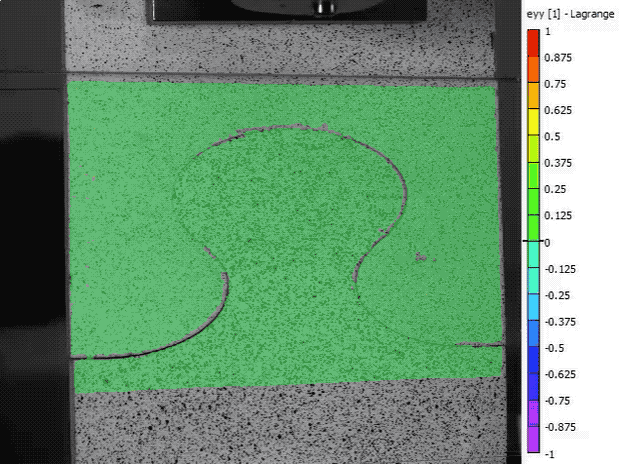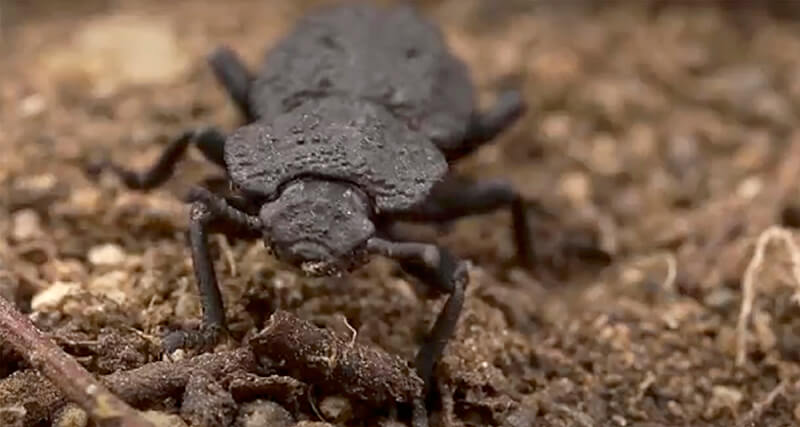October 21, 2020
This beetle can survive getting run over by a car. Engineers are figuring out how.
WEST LAFAYETTE, Ind. — Getting run over by a car is not a near-death experience for the diabolical ironclad beetle.
How the beetle survives could inspire the development of new materials with the same herculean toughness, engineers show in a paper published Wednesday (Oct. 21) in Nature.
These materials would be stiff but ductile like a paper clip, making machinery such as aircraft gas turbines safer and longer-lasting, the researchers said.
The study, led by engineers at the University of California, Irvine (UCI) and Purdue University, found that the diabolical ironclad beetle’s super-toughness lies in its two armorlike “elytron” that meet at a line, called a suture, running the length of the abdomen. (See a video of what this suture looks like.)
In flying beetles, the elytra protect wings and facilitate flight. But the diabolical ironclad beetle doesn’t have wings. Instead, the elytra and connective suture help to distribute an applied force more evenly throughout its body.
“The suture kind of acts like a jigsaw puzzle. It connects various exoskeletal blades – puzzle pieces – in the abdomen under the elytra,” said Pablo Zavattieri, Purdue’s Jerry M. and Lynda T. Engelhardt Professor of Civil Engineering.
This jigsaw puzzle comes to the rescue in several different ways depending on the amount of force applied, Zavattieri said. A video explaining these findings is available on YouTube.
To uncover these strategies, a team led by UCI professor David Kisailus first tested the limits of the beetle’s exoskeleton and characterized the various structural components involved by looking at CT scans.
 The diabolical ironclad beetle has puzzle piece-like blades in its abdomen that “delaminate” to prevent the beetle’s exoskeleton from suddenly failing under immense force. Purdue researchers simulated this mechanism using 3D-printed versions of the blades. (Purdue University video/Maryam Hosseini and Pablo Zavattieri)
The diabolical ironclad beetle has puzzle piece-like blades in its abdomen that “delaminate” to prevent the beetle’s exoskeleton from suddenly failing under immense force. Purdue researchers simulated this mechanism using 3D-printed versions of the blades. (Purdue University video/Maryam Hosseini and Pablo Zavattieri)
Using compressive steel plates, UCI researchers found that the diabolical ironclad beetle can take on an applied force of about 150 newtons – a load of at least 39,000 times its body weight – before the exoskeleton begins to fracture.
That’s more impressive than it sounds: A car tire would apply a force of about 100 newtons if running over the beetle on a dirt surface, the researchers estimate. Other terrestrial beetles the team tested couldn’t handle even half the force that a diabolical ironclad can withstand.
Zavattieri’s lab followed up these experiments with extensive computer simulations and 3D-printed models that isolated certain structures to better understand their role in saving the beetle’s life.
All of these studies combined revealed that when under a compressive load such as a car tire, the diabolical ironclad beetle’s jigsaw-like suture offers two lines of defense.
First, the interconnecting blades lock to prevent themselves from pulling out of the suture like puzzle pieces. Second, the suture and blades delaminate, which leads to a more graceful deformation that mitigates catastrophic failure of the exoskeleton. Each strategy dissipates energy to circumvent a fatal impact at the neck, where the beetle’s exoskeleton is most likely to fracture.
Even if a maximum force is applied to the beetle’s exoskeleton, delamination allows the interconnecting blades to pull out from the suture more gently. If the blades were to interlock too much or too little, the sudden release of energy would cause the beetle’s neck to snap.
It’s not yet known if the diabolical ironclad beetle has a way to heal itself after surviving a car “accident.” But knowing about these strategies could already solve fatigue problems in various kinds of machinery.
“An active engineering challenge is joining together different materials without limiting their ability to support loads. The diabolical ironclad beetle has strategies to circumvent these limitations,” said David Restrepo, an assistant professor at the University of Texas at San Antonio who worked on this project as a postdoctoral researcher in Zavattieri’s group.
In the gas turbines of aircraft, for example, metals and composite materials are joined together with a mechanical fastener. This fastener adds weight and introduces stress that could lead to fractures and corrosion.
“These fasteners ultimately decrease the performance of the system and need to be replaced every so often. But the interfacial sutures of the diabolical ironclad beetle provide a robust and more predictable failure that could help solve these problems,” said Maryam Hosseini, who worked on this project as a Ph.D. student and postdoctoral researcher in Zavattieri’s group. Hosseini is now an engineering manager at Procter & Gamble Corp.
UCI researchers built a carbon fiber composite fastener mimicking a diabolical ironclad beetle’s suture. Purdue researchers found through loading tests that this fastener is just as strong as a standard aerospace fastener, but significantly tougher.
 Researchers have discovered that the diabolical ironclad beetle can take on a load of at least 39,000 times its body weight before its exoskeleton begins to fracture. (Image provided by Kisailus Biomimetics and Nanostructured Materials Lab, University of California, Irvine)
Researchers have discovered that the diabolical ironclad beetle can take on a load of at least 39,000 times its body weight before its exoskeleton begins to fracture. (Image provided by Kisailus Biomimetics and Nanostructured Materials Lab, University of California, Irvine)
“This work shows that we may be able to shift from using strong, brittle materials to ones that can be both strong and tough by dissipating energy as they break. That’s what nature has enabled the diabolical ironclad beetle to do,” Zavattieri said.
This research is financially supported by the Air Force Office of Scientific Research and the Army Research Office through the Multi-University Research Initiative (award number FA9550-15-1-0009). The study used resources at the Advanced Light Source, a U.S. Department of Energy Office of Science User Facility.
About Purdue University
Purdue University is a top public research institution developing practical solutions to today’s toughest challenges. Ranked the No. 5 Most Innovative University in the United States by U.S. News & World Report, Purdue delivers world-changing research and out-of-this-world discovery. Committed to hands-on and online, real-world learning, Purdue offers a transformative education to all. Committed to affordability and accessibility, Purdue has frozen tuition and most fees at 2012-13 levels, enabling more students than ever to graduate debt-free. See how Purdue never stops in the persistent pursuit of the next giant leap at https://purdue.edu/.
Writer, Media contact: Kayla Wiles, 765-494-2432, wiles5@purdue.edu
Source: Pablo Zavattieri, zavattie@purdue.edu
Journalists visiting campus: Journalists should follow Protect Purdue protocols and the following guidelines:
- Campus is open, but the number of people in spaces may be limited. We will be as accommodating as possible, but you may be asked to step out or report from another location.
- To enable access, particularly to campus buildings, we recommend you contact the Purdue News Service media contact listed on the release to let them know the nature of the visit and where you will be visiting. A News Service representative can facilitate safe access and may escort you on campus.
- Correctly wear face masks inside any campus building, and correctly wear face masks outdoors when social distancing of at least six feet is not possible.
ABSTRACT
Toughening Mechanisms of the Elytra of the Diabolical Ironclad
Beetle
Jesus Rivera, Maryam Sadat Hosseini, David Restrepo, Satoshi Murata,
Drago Vasile, Dilworth Y. Parkinson, Harold S. Barnard, Atsushi Arakaki, Pablo
Zavattieri, David Kisailus
DOI: 10.1038/s41586-020-2813-8
Joining dissimilar materials such as plastics and metals in engineered structures currently remains a challenge. Mechanical fastening, conventional welding, and adhesive bonding are examples of techniques currently used to circumvent joining issues. However, each of these methods presents their own set of problems2. Nature has evolved efficient strategies, exemplified in the biological tissues of numerous animal and plant species, to synthesize, construct and integrate composites that exhibit exceptional mechanical properties. One such example is found in the exoskeletal forewings (elytra) of the diabolical iron clad beetle, Phloeodes diabolicus. Lacking the ability to fly away from predators, this desert insect exhibits an extremely impact and crush-resistant elytra via complex and graded interfaces. Here, utilizing advanced microscopy, spectroscopy and in-situ mechanical testing, we reveal previously unreported and critical multiscale architectural designs within the exoskeleton of this impressive beetle, the resulting mechanical response and subsequent toughening mechanisms. We highlight a series of interdigitated sutures, whose ellipsoidal geometry and laminated microstructure provide significant mechanical interlocking and toughening at critical strains, while avoiding catastrophic failure. These observations provide blueprints to tough, impact and crush resistant materials that can benefit applications where integration of dissimilar materials or joining is challenging, as demonstrated using biomimetic composites that show a significant increase in toughness versus a commonly used engineering joint.
Note to journalists: A video about the research is available on YouTube. For a copy of the paper, please contact Kayla Wiles, Purdue News Service, at wiles5@purdue.edu or 765-494-2432. Multimedia of the diabolical ironclad beetle research is available via Google Drive. Journalists visiting campus should follow visitor health guidelines.

